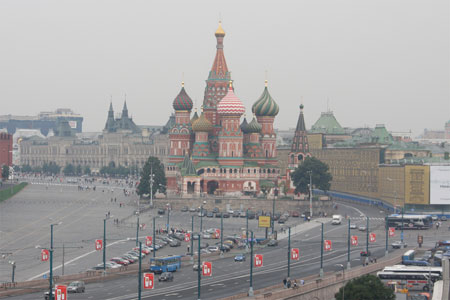
"There are 20 million people in Moscow," my driver carefully enunciates in broken English, "and there are 50 million cars." Both figures are highly exaggerated, but considering the trek from the airport to the hotel should take around 45 minutes, and we're deep into our second hour of gridlock, his estimates almost seem plausible.
In reality, Moscow houses around 12 million of Russia's 143 million people, and only 20 percent of the total population owns a vehicle. Compare that to the rest of Europe (around 30 percent) and the U.S. (over 70 percent), and then add an expanding economy, and it's a wonder that the mainstream media insists on having Russia play third fiddle to China and India on the global automotive stage.
That's all changed this week.
We'll try to avoid statistics and projections as best we can, but the numbers speak volumes about Russia's pent-up demand for motorized transport. While Lada remains the de facto brand most pistonheads associate with the former communist republic (and remains the butt of several jokes), sales of foreign marques rose 46 percent so far this year, with units sold expected to crest three million in 2008 and doubling in the next few years. Russia is on course to become the largest automotive market in Europe, easily eclipsing Germany – where sales have remained flat -- by the end of 2008. This has caused several automakers to take the Russian market very seriously, and it's evident by the turnout at this week's Moscow International Motor Show.
Audi, BMW, Lexus, Mazda and Renault debuted new models to the world and nearly every major (and minor) automaker had stands to rival some of the biggest shows in Europe.
General Motors is one of several foreign automakers expanding its reach in Russia, both from a product and manufacturing standpoint. GM has seen sales increase exponentially over the last three years, with a 390 percent growth in Russia between 2004 and 2007, and sales up 60 percent for the first half of 2008. The General markets Chevrolet, Opel, Saab, Cadillac and HUMMER brands in Russia, with Chevy growing some 45 percent in 2008, along with Saab and Opel, which have seen sales increases of 77 and 95 percent, respectively. All of which have contributed to GM becoming the largest imported brand in the country.
In order to keep up with demand, GM, along with Toyota, Hyundai, Suzuki and Ford, are all expanding their manufacturing base in Russia. St. Petersburg has become the new boomtown for car production, taking the top slot away from Moscow where finding land and building plants has become prohibitively expensive. By the end of the year, GM will have increased its production capacity by 100,000 vehicles and has 156 dealers peddling its wares across the country, with more outlets coming online at a staggering pace.
So what's driving the market? A 13 percent flat tax is imposed and growing incomes have provided buyers with more expendable income. Gas is relatively inexpensive (around $1 per liter) and the middle class is growing at one of the highest rates in Europe. As you'd expect, sales of entry-level models have increased, with the Ford Focus and Chevy Lacetti leading the charge. But you'd be forgiven for thinking that incomes in Moscow reach into the stratosphere by the number of BMWs, Mercedes and Land Rovers trolling the congested streets.
"We are a young economy and people need to show their wealth and success." Alexander Gubsky, Russia Business Daily's deputy editor in chief told Autoblog. "[A] buyer may not be too wealthy, but he'll still buy a Mercedes."
This desire to be seen as affluent expands beyond the car market and into the retail sector, with every high-end outlet of overpriced wares sold in Russia's numerous upscale malls.
However, Russia's domestic automakers haven't been left out of the boom. Lada sales have increased 37 percent this year and with new, budget-oriented products in the pipeline, the automaker is capitalizing on some consumers' lack of badge snobbery. That same motivation is helping several Chinese automakers, which are quickly becoming a force to be reckoned with on the low end of the automotive totem pole.
While every automaker we talked to in Russia recognizes that the booming economy and steeply increasing car sales won't last forever, each is making a serious push to make their presence known. With sales remaining stagnant in several parts of the world and decreasing in the U.S., automakers recognize the necessity of capitalizing on the growth in expanding markets like Russia. How long it will continue remains to be seen, but in a booming economy, it's sometimes hard to focus on the long-term future.
Travel and lodging for our coverage and other media outlets was provided by GM.


Sign in to post
Please sign in to leave a comment.
Continue